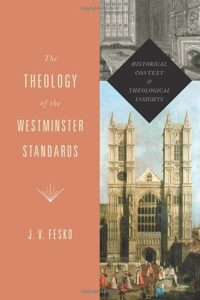
Learning to Read a Confession of Faith in Historical Context
It is often said that the three most important rules to purchasing real estate are location, location, location. A similar maxim is true for good historical theology—context, context, context. T he best explanations of the doctrine of the Westminster Standards must rest upon the testimony of the time. Such a contextual reading of the Standards will undoubtedly produce several important results. By enmeshing the Standards in their original context, the reader is forced to look for cognitive dis-sonances, that is, things that do not quite fit the contemporary way of stating or understanding things. True, many people still profess the Reformed faith as found in the Westminster Standards, but much has changed over the last 350-plus years. Think for a moment about what was happening in our own country twenty-five, fifty, or one hundred years ago; things were quite different. The seventeenth century was a period that was marked, for example, by different general beliefs about the world. The seventeenth century was a period when most Protestant theologians, with little dissenting opinion, believed that the pope was the antichrist; this was a virtually unquestioned fact. It was also a period when people believed in ghosts and spirits. In one such account, the supposed testimony of the ghost of an old woman played a role in the execution of a bishop, John Atherton (1598–1640). What has this ghost’s tale to do with the Westminster Standards?
he best explanations of the doctrine of the Westminster Standards must rest upon the testimony of the time. Such a contextual reading of the Standards will undoubtedly produce several important results. By enmeshing the Standards in their original context, the reader is forced to look for cognitive dis-sonances, that is, things that do not quite fit the contemporary way of stating or understanding things. True, many people still profess the Reformed faith as found in the Westminster Standards, but much has changed over the last 350-plus years. Think for a moment about what was happening in our own country twenty-five, fifty, or one hundred years ago; things were quite different. The seventeenth century was a period that was marked, for example, by different general beliefs about the world. The seventeenth century was a period when most Protestant theologians, with little dissenting opinion, believed that the pope was the antichrist; this was a virtually unquestioned fact. It was also a period when people believed in ghosts and spirits. In one such account, the supposed testimony of the ghost of an old woman played a role in the execution of a bishop, John Atherton (1598–1640). What has this ghost’s tale to do with the Westminster Standards?
The Importance of the Original Historical Context
This slice of early modern English history is but one small example of how differently things functioned during the time of the Westminster Assembly. One might certainly debate the existence of ghosts in our own day, but to say with a serious face that a message from a ghost would play a part in the arrest, conviction, and execution of a church official must surely be the stuff of fiction, not history. Yet, this is precisely what happened in the case of Bishop Atherton’s execution. When the layers of this bizarre case are pulled away, they reveal that Bishop Atherton was opposed to Laud’s imposition of high-church Arminian and Papist practices upon the Church of England, and that the rumors surrounding Mother Leakey’s ghost, as well as the false charge of buggery, were quite possibly an elaborate conspiracy to discredit and remove Atherton and replace him with a bishop more congenial to Laud’s policies. Early modern Reformed theologians had a slightly different outlook on life and theology than we do today, and despite whatever similarities are shared with theologians in the twenty-first century, the differences can be significant. Click To TweetAdding to the complexity of the politics and religion of the time, a number of Presbyterians, including Westminster divine Robert Baillie (1602–1662), saw the conviction of Bishop Atherton as further reason to reject and remove Episcopacy “root and branch,” given its corruption. This whole event is but one illustration of the differences between the seventeenth century and the present day.
Theologically speaking, the Standards contain curious turns of phrase, oblique rejections of doctrines without persons or responsible parties named, and peculiar terms—such things that often pass unnoticed by contemporary readers but were well-known to theologians of the period. What, for example, does the term general equity mean (19.4) and what is the difference between the moral law as a covenant and as a rule (19.5)? Why does the Confession say that the kingdom of Christ is the visible church (25.2), whereas God, not Christ, is the “Supream Lord and King of all the world” (23.1)? When the Confession states that God has ordained “whatsoever comes to pass,” but at the same time his decree has not taken away “liberty or contingency of second Causes” but rather has established them (3.1), how can the divines affirm both a sovereign decree and contingency? Why do the Standards never employ the word atonement (or its variants) when such a word is commonplace in contemporary Reformed theology, especially with regard to popular terms such as limited atonement? All of these are questions that we need to ask when reading the Standards, and they can only be answered by investigating the Standards in their original context. Early modern Reformed theologians had a slightly different outlook on life and theology than we do today, and despite whatever similarities in doctrine and conviction are shared with theologians in the twenty-first century, the differences can be significant.
Learning to Read a Confession of Faith
A benefit of reading the Westminster Standards within their original historical and theological context is that the contemporary reader learns how to read a confession of faith. In the present day those who employ confessions of faith often fail to understand that confessions can be highly nuanced documents. The running joke in Presbyterian circles is, “Put three Presbyterians in one room and you’ll get five different opinions.” This humorous observation is equally true of Reformed theology in the early modern period. Confessions of faith were typically written to define truth and fence off heterodoxy and heresy while allowing a degree of doctrinal latitude within the boundaries of the confession. The Confession, for example, explicitly rejects certain doctrines, such as predestination based upon foreknowledge (3.2), justification based upon the worthiness of one’s faith (11.1), or transubstantiation (29.6). However, the Westminster Confession is equally silent about a number of other teachings, which typically were viewed as issues of doctrinal liberty—issues upon which theologians could disagree but still be within the bounds of confessional orthodoxy. A benefit of reading the Westminster Standards within their original historical and theological context is that the contemporary reader learns how to read a confession of faith. Click To TweetIn the debates over God’s decree, for example, and the composition of the Confession’s third chapter, one of the divines, George Gillespie (1613–1648), wanted the assembly to compose certain phrases in such a manner that “every one may injoy his owne sence.”
In other words, at many points the Confession is very specific in terms of what it rejects or teaches, but at other points it is brilliantly ambiguous or vague, thus allowing various theologians to assent to the document even though it might not advocate each theologian’s precise view on a particular subject. Such deliberate ambiguity or vagueness can only be discovered by reading the Confession and catechisms in tandem with the minutes of the assembly and works of the period. For example, one of the more complex issues in theology, whether in the present day or in the seventeenth century, is the relationship of the Mosaic covenant to the other covenants in Scripture; or alternatively stated, what is the Christian’s relationship to the Mosaic law? Today many might not realize that at least five different views were held by various commissioners to the assembly. The Confession states the basics of what was the most common view, but when it came to its rejection of other views, it singled out only one position, namely, that of Tobias Crisp (1600–1643). Crisp advocated that there were two covenants of grace, something the Confession explicitly rejects (7.6). It is silent with regard to the other views held.
The above excerpt is from The Theology of the Westminster Standards: Historical Context and Theological Insights by J. V. Fesko. Crossway Publishing, a ministry of Good News Publishers. © 2014. Used by permission.

